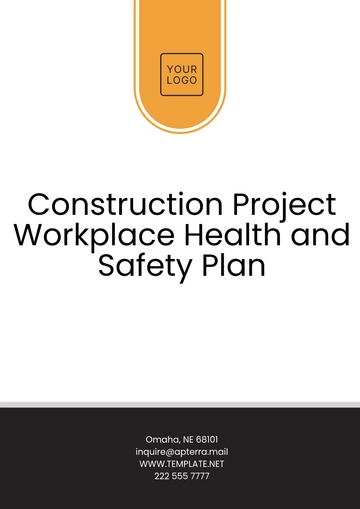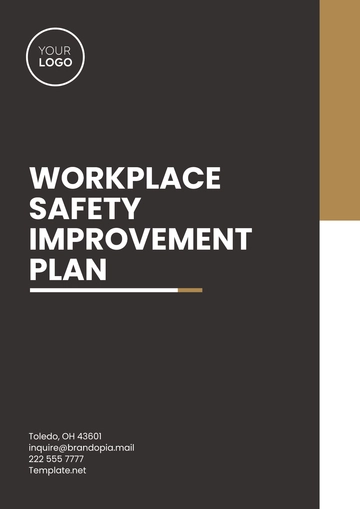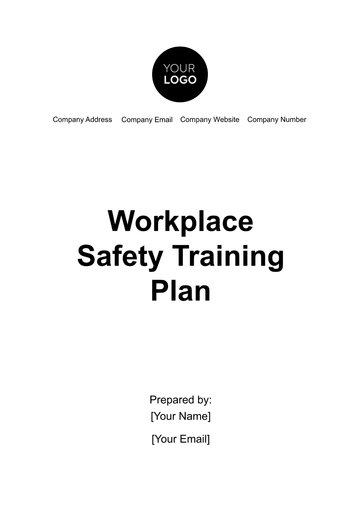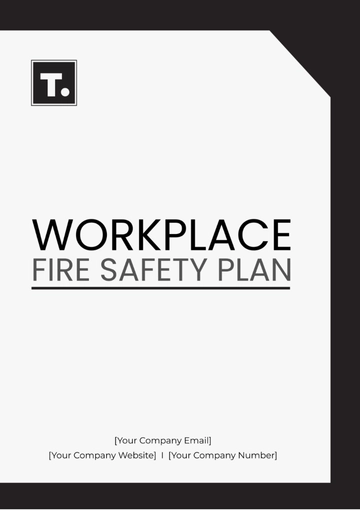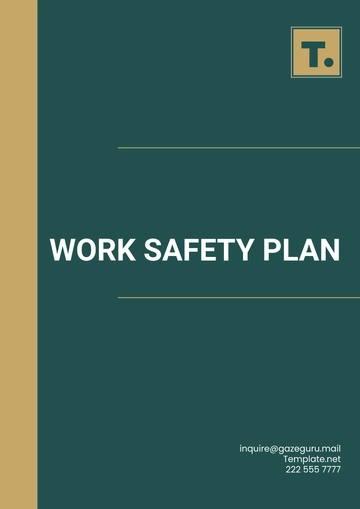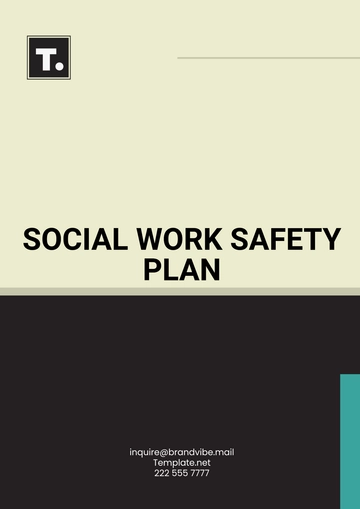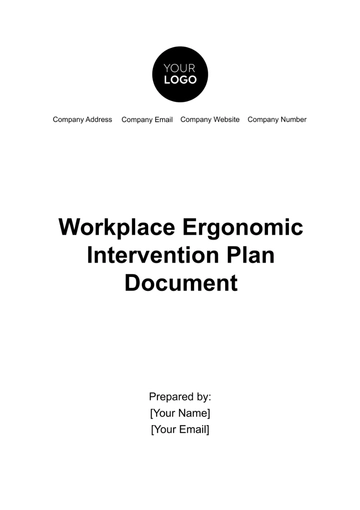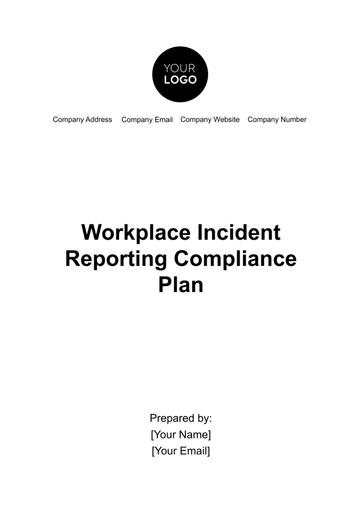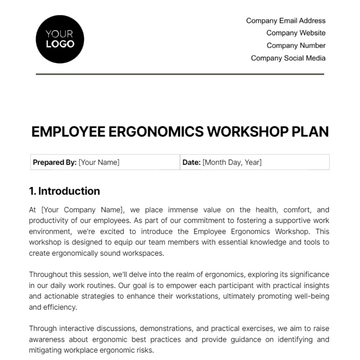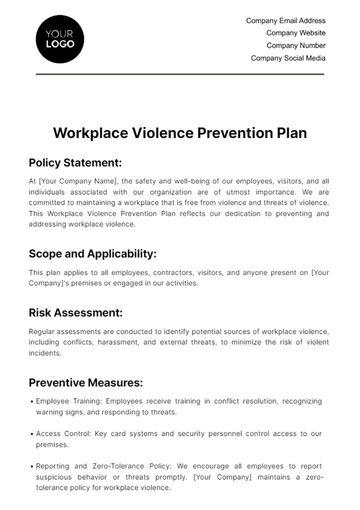Free Workplace Safety Training Plan
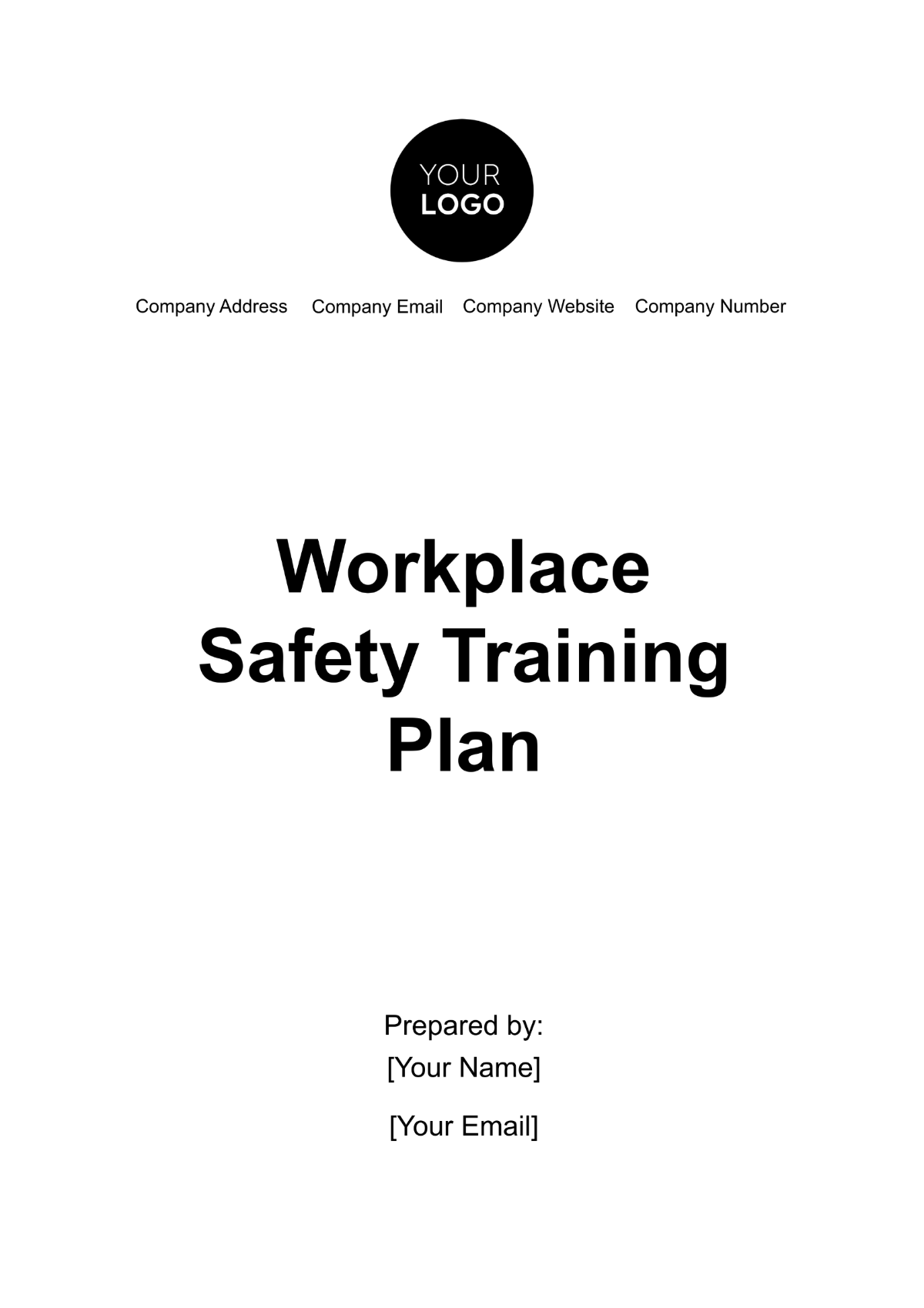
I. Overview
At [Your Company Name], maintaining a safe and healthy workplace is a top priority. Our Workplace Safety Training Plan is designed to ensure that all employees are equipped with the knowledge and skills necessary to prevent accidents, respond to emergencies, and comply with relevant safety regulations. This plan encompasses a comprehensive approach, addressing various aspects of workplace safety including hazard identification, emergency response procedures, and ongoing safety training. By fostering a culture of safety, we aim to protect our employees, minimize risks, and maintain a productive work environment.
Our safety training program aligns with OSHA (Occupational Safety and Health Administration) standards and other relevant federal and state regulations. It includes initial training for new hires, periodic refresher courses, and specialized training for specific job functions or hazards. The plan also outlines procedures for reporting safety concerns, conducting safety inspections, and handling incidents. [Your Company Name] is committed to continuously improving our safety practices and ensuring that every employee is informed and prepared to contribute to a safe working environment.
II. Objectives
Our Workplace Safety Training Plan is designed with clear objectives to enhance workplace safety and ensure regulatory compliance. The primary goals of this plan are:
To provide employees with the knowledge and skills to identify, prevent, and manage workplace hazards.
To ensure compliance with occupational safety and health regulations.
To encourage a culture of safety within the organization.
These objectives guide our training efforts and help create a safer, more compliant work environment at [Your Company Name].
III. Training Schedule
To effectively implement our Workplace Safety Training Plan, a structured schedule of training sessions is essential. This schedule outlines the specific dates, topics, trainers, and durations for each training session, ensuring that employees receive comprehensive and timely instruction. Each session is designed to cover critical aspects of workplace safety, ranging from fundamental safety principles to specialized emergency procedures and equipment safety.
The table below provides a detailed overview of the planned training sessions, including their respective dates, topics, trainers, and durations. This organized approach allows us to systematically address key safety issues and maintain a consistent focus on enhancing our safety culture at [Your Company Name].
Date | Topic | Trainer | Duration |
|---|---|---|---|
[Month Day, Year] | Introduction to Workplace Safety | [Name] | 2 hours |
[Month Day, Year] | Emergency Procedures | [Name] | 3 hours |
[Month Day, Year] | Equipment Safety | [Name] | 2 hours |
IV. Training Modules
Effective workplace safety training requires a structured approach to ensure all critical areas are addressed. The following modules are designed to cover essential aspects of workplace safety, equipping employees with the necessary knowledge and skills to maintain a safe working environment. Each module focuses on specific topics relevant to our operations and safety requirements.
Below is the outline of the key training modules included in our Workplace Safety Training Plan. This organized presentation helps ensure that all relevant topics are systematically addressed and communicated effectively to all employees at [Your Company Name].
Module | Topics Covered |
|---|---|
Introduction to Workplace Safety |
|
Emergency Procedures |
|
Equipment Safety |
|
V. Evaluation
To ensure the effectiveness of our Workplace Safety Training Plan and to assess the comprehension and application of safety principles, a comprehensive evaluation process has been established. This process is designed to gauge the knowledge and skills of employees and ensure that the training objectives are met. Evaluation methods are crucial for identifying areas where additional support may be needed and for reinforcing the importance of workplace safety.
Quizzes after each module: At the end of each training module, employees will complete a quiz designed to test their understanding of the material covered. These quizzes will assess key concepts, procedures, and best practices discussed during the training. The results will help determine whether employees have grasped the essential safety information and identify any areas requiring further review.
Practical assessments: Practical assessments will be conducted to evaluate employees' ability to apply the knowledge and skills learned during the training. These assessments will involve real-world scenarios where employees must demonstrate their proficiency in emergency response, equipment handling, and other critical safety practices. Practical assessments provide a hands-on approach to ensure that employees can effectively implement safety procedures in their daily tasks.
Feedback from trainers: Trainers will provide feedback on employees' performance during training sessions and practical assessments. This feedback will include observations on employees' engagement, understanding, and application of safety practices. Trainers will also be available to answer questions and offer additional guidance as needed. Regular feedback helps employees improve their safety skills and encourages a continuous learning process.
Overall, the evaluation methods employed will help us maintain high safety standards, reinforce the importance of safety training, and ensure that all employees at [Your Company Name] are well-prepared to contribute to a safe and secure work environment.
VI. Follow-Up
To ensure the ongoing effectiveness of our Workplace Safety Training Plan and adapt to evolving safety needs, a structured follow-up process is essential. This process focuses on continuous improvement, regular reassessment, and active engagement with employees to maintain high safety standards.
Annual refresher courses: To keep safety knowledge current and reinforce key concepts, employees will participate in annual refresher courses. These courses will review critical safety practices, introduce updates to safety regulations, and address any new hazards identified in the workplace. This periodic training helps employees stay informed and prepared for potential safety challenges.
Regular updates on safety protocols: Safety protocols and procedures will be regularly reviewed and updated to reflect changes in regulations, industry standards, and workplace conditions. Employees will be promptly informed of any updates to ensure that they are always operating according to the latest safety guidelines.
Open channels for employee suggestions and feedback: We encourage employees to actively participate in the safety program by providing suggestions and feedback. Open channels of communication allow employees to report safety concerns, propose improvements, and share their experiences. This collaborative approach helps us address potential issues, implement effective solutions, and continuously enhance our safety practices.
VII. Contact Information
For any questions or further information, please contact us:
[Your Company Name]
[Your Company Address]
Email: [Your Company Email]
Phone: [Your Company Number]
Website: [Your Company Website]
Follow us on Social Media: [Your Company Social Media]
- 100% Customizable, free editor
- Access 1 Million+ Templates, photo’s & graphics
- Download or share as a template
- Click and replace photos, graphics, text, backgrounds
- Resize, crop, AI write & more
- Access advanced editor
Promote a safer work environment with the Workplace Safety Training Plan Template from Template.net. Fully customizable and editable, this template provides a detailed format for outlining training objectives, schedules, and safety protocols. Editable in our AI Editor Tool, it ensures your training plan is comprehensive, clear, and tailored to your organization’s specific safety needs.
You may also like
- Finance Plan
- Construction Plan
- Sales Plan
- Development Plan
- Career Plan
- Budget Plan
- HR Plan
- Education Plan
- Transition Plan
- Work Plan
- Training Plan
- Communication Plan
- Operation Plan
- Health And Safety Plan
- Strategy Plan
- Professional Development Plan
- Advertising Plan
- Risk Management Plan
- Restaurant Plan
- School Plan
- Nursing Home Patient Care Plan
- Nursing Care Plan
- Plan Event
- Startup Plan
- Social Media Plan
- Staffing Plan
- Annual Plan
- Content Plan
- Payment Plan
- Implementation Plan
- Hotel Plan
- Workout Plan
- Accounting Plan
- Campaign Plan
- Essay Plan
- 30 60 90 Day Plan
- Research Plan
- Recruitment Plan
- 90 Day Plan
- Quarterly Plan
- Emergency Plan
- 5 Year Plan
- Gym Plan
- Personal Plan
- IT and Software Plan
- Treatment Plan
- Real Estate Plan
- Law Firm Plan
- Healthcare Plan
- Improvement Plan
- Media Plan
- 5 Year Business Plan
- Learning Plan
- Marketing Campaign Plan
- Travel Agency Plan
- Cleaning Services Plan
- Interior Design Plan
- Performance Plan
- PR Plan
- Birth Plan
- Life Plan
- SEO Plan
- Disaster Recovery Plan
- Continuity Plan
- Launch Plan
- Legal Plan
- Behavior Plan
- Performance Improvement Plan
- Salon Plan
- Security Plan
- Security Management Plan
- Employee Development Plan
- Quality Plan
- Service Improvement Plan
- Growth Plan
- Incident Response Plan
- Basketball Plan
- Emergency Action Plan
- Product Launch Plan
- Spa Plan
- Employee Training Plan
- Data Analysis Plan
- Employee Action Plan
- Territory Plan
- Audit Plan
- Classroom Plan
- Activity Plan
- Parenting Plan
- Care Plan
- Project Execution Plan
- Exercise Plan
- Internship Plan
- Software Development Plan
- Continuous Improvement Plan
- Leave Plan
- 90 Day Sales Plan
- Advertising Agency Plan
- Employee Transition Plan
- Smart Action Plan
- Workplace Safety Plan
- Behavior Change Plan
- Contingency Plan
- Continuity of Operations Plan
- Health Plan
- Quality Control Plan
- Self Plan
- Sports Development Plan
- Change Management Plan
- Ecommerce Plan
- Personal Financial Plan
- Process Improvement Plan
- 30-60-90 Day Sales Plan
- Crisis Management Plan
- Engagement Plan
- Execution Plan
- Pandemic Plan
- Quality Assurance Plan
- Service Continuity Plan
- Agile Project Plan
- Fundraising Plan
- Job Transition Plan
- Asset Maintenance Plan
- Maintenance Plan
- Software Test Plan
- Staff Training and Development Plan
- 3 Year Plan
- Brand Activation Plan
- Release Plan
- Resource Plan
- Risk Mitigation Plan
- Teacher Plan
- 30 60 90 Day Plan for New Manager
- Food Safety Plan
- Food Truck Plan
- Hiring Plan
- Quality Management Plan
- Wellness Plan
- Behavior Intervention Plan
- Bonus Plan
- Investment Plan
- Maternity Leave Plan
- Pandemic Response Plan
- Succession Planning
- Coaching Plan
- Configuration Management Plan
- Remote Work Plan
- Self Care Plan
- Teaching Plan
- 100-Day Plan
- HACCP Plan
- Student Plan
- Sustainability Plan
- 30 60 90 Day Plan for Interview
- Access Plan
- Site Specific Safety Plan
